|
Irrigation pump issues...
Jeff Johnson, The Minikahda Club, Minneapolis, MN:
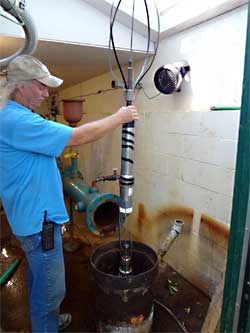
Above, the camera being lowered down the well casing. Below, the view from the camera inside the truck.
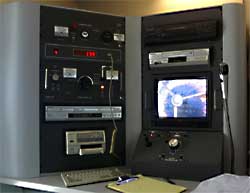
|
 "Since July 22nd we have been operating the irrigation system with only 36% of our total capable capacity. The pump on Well #1 quit working and we have been forced to rely solely on our secondary pump (thankfully we have a second well). The reason for the broken pump is yet to be determined. In fact today the well company was finally able to extract the pump. We do know that the main shaft broke and this caused the pump to fall to a depth of 316ft down the well casing. We know the exact depth since we had to have a company investigate the casing with a camera so we could determine if the pump was still in the well and if so what its condition was.
Once the pipe column was located, McCarthy Well had to fabricate a jig to fish for the column so the pump could be retrieved. Success happened last week and after a few days of removing the column pipes, 10 ft at a time, the pump was finally removed today. Most of the shaft, rubber gaskets and spiders were all destroyed. At this time we do not know what is repairable and if replacing with a new pump will be necessary. The entire process has been quite slow and thankfully we have had a break in the weather as well as a few rain events to help us manage our irrigation needs.
The loss of our main pump for an extended period is an excellent example of why we want to encourage creeping bentgrass as our main sward of fine turf. We also want to encourage deep rooting plants that are not conditioned to require water on a nightly basis. We typically water our fine playing surfaces deep and infrequent to encourage deeper more healthy roots. Something we have been very successful at on our tees and fairways. With our current pump situation we are limited to how much water can be applied at night and are forced to make light infrequent applications. Not something we encourage but are forced to do out of necessity. Thankfully this is a temporary (although we don't know for how long) adjustment to our maintenance practices and once the pump is up and running we will return to our deep and infrequent philosophy for irrigating fairways and tees.
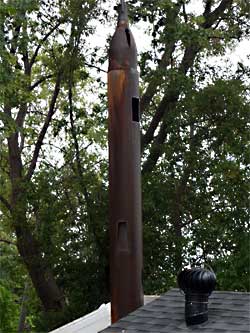
Fabricated jig built to fish the pipe column that was resting at 316ft.
|
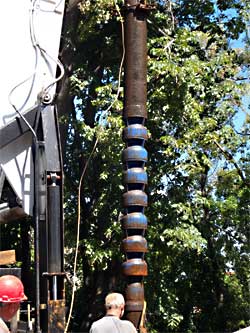
Success!
|
This vertical turbine pump has seven bowls and has the ability to pump 900gpm when its completely maxed but we only run it at 700 gpm. McCarthy Well will now take the pump back to their shop to inspect and determine what the next course of action will be."
Visit Jeff's blog at minikahdagrounds.blogspot.com.
|
 |
|
Deep Drilling Greens...
Paul L. Carter, CGCS, Bear Trace at Harrison Bay, Harrison, TN:
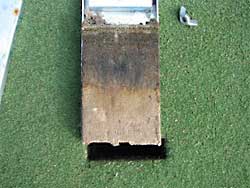  "What do you do when your greens reach the point where they are so contaminated with organic matter and have formed a hard pan layer from years of conventional aerification that roots, air and water cannot penetrate through the soil profile?
Answer... You bring out the big guns. Today we deep drilled three greens (14, 16, and 17) with 5/8" tines which penetrated the greens to a depth of 10 inches.
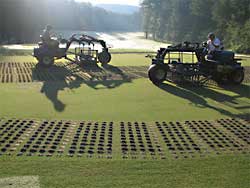
The process was masterfully done by Southeastern Turf Maintenance in just a couple of hours.
|
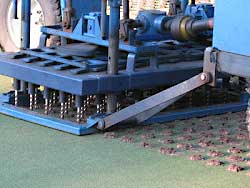
The drills are set on a continuous plate which holds 50 drill bits.
|
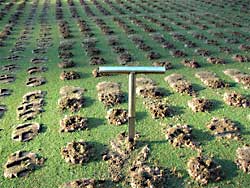
Depth of soil probe when place in drill hole.
|
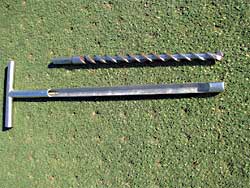
Deep drill tine in comparison to soil probe.
|
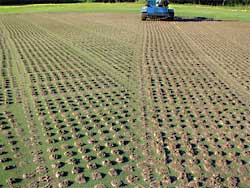
We chose to double drill #16 green since it has given us the most issues this year. This is half way through the second drilling on the green.
|
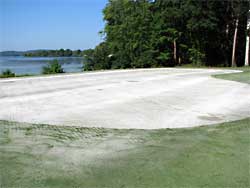
The greens should recover completely in a matter of a week or two.
|
All the material brought to the surface by the drilling process was picked up and removed from the green. The green was then topdressed, allowed to dry for a while, dragged in with a carpet drag and then rolled several times. The deep drilling will allow for water and oxygen to move throughout the soil profile of these greens which will allow for the roots to thrive and the green to recover completely in a matter of a week or two. If this works out to the extent we believe it will we will look at doing all the greens next year when we close for mid season aerification.
"
Visit Paul's blog at bthbgcm.blogspot.com.
|
 |
|
FCC change...
Patrick Quinlan, Madison (NJ) Golf Club:
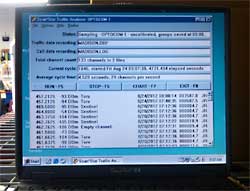  "The FCC is mandating that all golf courses switch from wide band controlled irrigation communication to narrow band communication. This process is a lengthy and expensive conversion that is required by law. For the next five days Storr Tractor (local Toro distributor) has setup a temporary computer and antenna to record all the different radio frequencies in our area to determine which four frequencies will be best for our new FCC license."
Visit Pat's blog at mgcgreens.blogspot.com.
|
 |
|
How Do You Stop Etiolation?
John Slade, Laurel Creek Country Club, Mt. Laurel, NJ:
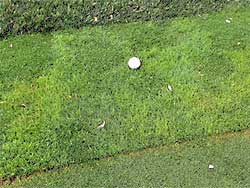
Patches of etiolated bentgrass can be seen in the collar(2011 photo).
|
 "After dealing with some significant thinning of several greens the past two summers caused by etiolation, we got through 2012 with minimal turf damage. How? Well, it certainly was not because of a lack of weather-related stress on the turf, as July tied or broke several heat records.
First, what exactly is etiolation?
Basically, the symptoms of etiolation in turf are thin, pale and elongated plants, similar to what you'd see in white asparagus. Eventually, the weakened turf can collapse and die. On putting greens, samples exhibiting these symptoms also tend to have high bacteria counts, which can clog the plant's 'blood stream'. This is where the debate among members of the scientific community occurs: Is the bacteria a cause of the etiolation and subsequent wilt, or merely a secondary pathogen, that is taking advantage of an already weakened plant?
"...samples exhibiting these symptoms also tend to have high bacteria counts, which can clog the plant's 'blood stream'." |
Whether the bacteria is a cause or effect is not important from our perspective. Regardless of the actual cause, preventing, controlling and managing etiolation has become the goal. With that in mind, over the past two years we've worked at developing a set of best management practices in dealing with etiolation in the greens by researching countless articles, attending seminars, discussing the issue with other course managers, consultants and scientists from around the country, and even offered the use of our practice green for a USGA funded study.
A possible solution
One plant pathologist believes there is a connection between the occurrence of etiolation and turf fertility. While we have always kept the greens fairly lean, his recommendation was to cut back on the amount of Nitrogen applied even further. This seems to have been a key.
"Essentially, the turf got the equivalent of an occasional sports drink to make it through the summer..." |
However, this method is not without some risk. Because a putting green is built largely out of sand, which has little nutrient holding capacity, as we entered the summer it was like sending a marathon runner off to race without a good carbohydrate supply to use for energy. Essentially, the turf got the equivalent of an occasional sports drink to make it through the summer. To put this into perspective, your home lawn would typically receive 1 lb. of Nitrogen /1,000 square feet per application of fertilizer. While applying that much Nitrogen to a putting green in-season would never be a wise idea, we are now applying a miniscule rate of 0.03 lb./1,000 square feet.
Counterintuitive measures
In addition to this lean fertility program, we also stayed very aggressive with our mowing and rolling regimen throughout the summer. Raising the height of cut is a well documented way of decreasing plant stress, but we chose not to do that. And, from June 6 through August 13, the greens were mowed a minimum of once (and often twice) per day, every day. The idea behind these decisions was that etiolation is much like a plant growing out of control. If we didn't mow every day, there was a high likelihood that we would 'scalp' the turf when we resumed mowing.
"Raising the height of cut is a well documented way of decreasing plant stress, but we chose not to do that..." |
When you step back and look at some of the practices, they are counterintuitive to maintaining a healthy green, and so go against some of the rules of thumb of how to decrease plant stress. For example, mowing is a stress on the turf. And yet, in this case, if we chose not to mow, an even greater physical injury to the plant would occur. So how do you stop etiolation? In our case, the answer seems to be, by not managing the turf in a conventional manner.
Looking ahead
As we near the end of summer, we can exhale a bit as the turf is enjoying cooler nights, and recovering well. However, Mother Nature always has some new tricks for us, so we need to continue to research and understand the causes and the solutions to etiolation, as well as the many other enemies of good turf, that would try to keep all of us from enjoying the beauty of a great day on the greens."
Visit John's blog at laurelcreeksuper.blogspot.com.
|
 |
|
Why aren't the large dead spots on #6 fairway fixed yet?
Tony Gustaitis, CGCS, Whitemarsh Valley Country Club, Lafayette Hill, PA:
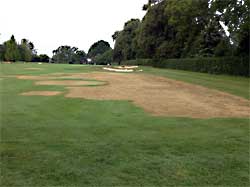  "It has been 17 days since the first application of a non-selective herbicide to eliminate Bermudagrass on the fairway. The second application was made four days ago with the same product. We are going to make one more application.
Why all these applications and waiting periods? Bermudagrass is one of the most difficult grasses to get rid off after it is established. We have to make sure the herbicide treatment has enough time to translocate through as much of the plant as possible. Once we are sure that we have effected enough of the Bermudagrass, the dead turf will be removed and sodded with Bentgrass.
This is an abrupt process but one that is necessary."
Visit Tony's blog at wvccgreens.blogspot.com
|
 |
|
Teeways and Efficiency...
Joel Kachmarek, Tacoma Country and Golf Club, Lakewood, WA:
 "After the Senior Member Guest concluded today, I was able to get some fantastic photos of the teeways on an empty golf course with the sun high in the sky. Here you see the 18th hole. This week we mowed the teeways down to our fairway height of 340/1000". Now we were actually able to mow them with the fairway mowers. Of course this was a learning experience seeing what we could and couldn't do with the large machines. Thank goodness I have fantastic operators who were able to just figure it out.
Because of the Senior MGI, we mowed teeways and fairways everyday this week. Each time we mow, we change the direction to come out with the stripeless look which I just love. I still don't know why some people today mow stripes. What a waste of time.
"Saving 15 man hours is like adding two people to my staff every day we mow that 31 acres. That's huge..." |
On the subject of time, using three fairway mowers, one small fairway mower, and one walker for the tight areas, we mowed all the fairways and teeways (31 acres) using 15 man hours. Back in the day, when I wasn't very smart and we striped fairways, walk mowed tees and dew strips, and then mowed rough between tees, that same 31 acres took 30 or more man hours to mow. Saving 15 man hours is like adding two people to my staff every day we mow that 31 acres. That's huge. So this weeks 9 am shotgun didn't really hurt us going into the weekend. All areas got mowed before the gun was fired.
Mowing that 31 acres of fine turf takes about half the time it used to. Our increase in efficiency doesn't stop there, though. Now that we don't have to mow the rough between the tee decks, we use the large rough machines to mow around the teeing grounds, and so the time it takes to mow that rough has been cut in half.
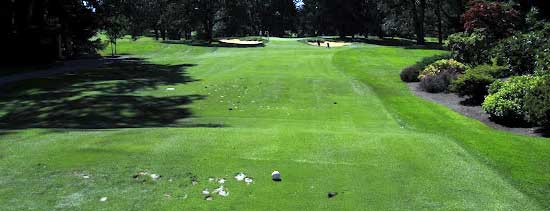
Here's the 6th hole. Before teeways, we could never put the blocks this far up on the blue deck, it would have been 6 inches past the rough which would not have been cool. We have gained countless new teeing areas with the teeways.
|
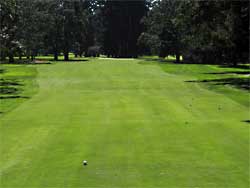
The 10th hole from the white teeing ground. There is no difference in the appearance of what once was rough and what once was tee. It all blends seamlessly.
|
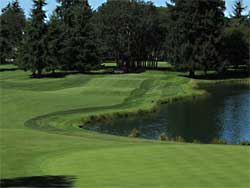
15 teeway from the green.
|
For more photos and commentary, visit Joel's blog at tacomaturf.com.
|
 |
|
Texting and driving... not quite.
Rick Tegtmeier, CGCS, Des Moines Golf & Country Club, W. Des Moines, IA:
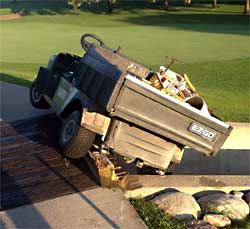  "We had a little accident on the golf course this morning and thankfully no one was hurt and no equipment was damaged. We were able to hook a chain to the cart and lift it right back into place.
The assistant who had this mishap was not texting and driving, however he was trying to operate the radio controlled irrigation system while he was driving his cart. I doubt this will happen again. I am sure he will not be driving and punching in numbers into his radio at the same time! He was a very lucky young man that he did not get hurt.
He was even luckier that he had a shock in the back left-hand corner of his cart that got hung up on the bridge."
Visit Rick's blog at dmgcc.blogspot.com.
|
 |
|
About our Blog Aggregator: Many superintendents are now hosting private blogs to better communicate with their golfers and/or members. Beyond local weather and course conditions, there is a great deal of information about projects, methodologies and techniques that would be of value to other superintendents — hence our Turf Blog Aggregator. As every blogger struggles occasionally with content, we also include posts intended to educate golfers about turf maintenance for others to use as a template for their own blogs.
Miss any previous issues of TBA? You can find them all here.
Turf Blog Aggregator(TM) is a trademark of Turnstile Media Group.
|
|